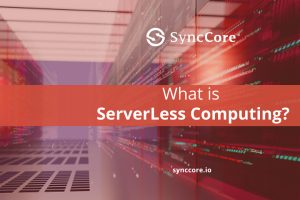Table of Contents
Cloud Analytics
If you run a business that generates and consumes any type of data set, you should be familiar with cloud analytics. Cloud analytics is data collection, tracking, and analysis that occurs on cloud-hosted systems rather than on-premises systems. These cloud-based analytics tools enable businesses to manage large data sets to improve business outcomes.
There are numerous applications for cloud analytics. Cloud analytics is a promising solution for analyzing website traffic, factory production efficiency, financial market data, climate trends based on satellite data, or understanding what’s being captured by sensors. This article will go over key details about cloud analytics that every business owner and decision-maker should be aware of.

What is Cloud Analytics?
When data is manipulated and analyzed remotely, as opposed to locally in an on-premises business system, this is referred to as cloud analytics. Users have access to, and the ability to aggregate, analyze, and make use of, analytics systems hosted in the cloud. With the help of these platforms, users can analyze sizable data sets, spot trends, and pinpoint areas where the organization needs to improve.
For a list of a few thousand data points, your laptop’s spreadsheet program or on-premises analytics may be adequate, but those who need to analyze complex data sets with tens of thousands to millions of inputs won’t have much success using such a program. Instead of building infrastructure to handle the process on-site, cloud analytics enables businesses to process large data sets in a scalable, more affordable way. That’s just one benefit of using the cloud’s power for your data analytics requirements.
Cloud Types
Although we often think of the cloud as a non-physical entity, the term refers to vast computer networks that are hosted in one or more data centers. One of the types of cloud models listed below may be appropriate for your analytics platform, depending on your needs and goals in terms of security, performance, and access, among other factors.
Public Cloud
A public cloud is a platform made available to anyone who wants to use or buy it over the open internet by third-party providers. It makes resources, such as virtual machines, applications, and storage, access to remote users using a common cloud computing model. You may frequently use websites, shopping apps, or software-as-a-service (SaaS) programs that manage email, calendars, projects, or even your bank accounts as public cloud resources.
Private Cloud
An on-demand computing system known as a private cloud is only accessible inside your private network. Private clouds are not accessible by any other company. They function similarly to the intranet of your business and other resources that you can only access when you are at work or connected to a virtual private network (VPN). When the underlying IT infrastructure is devoted to a single client with totally isolated access, all clouds become private clouds. Private clouds increase the ability of the infrastructure to handle large data storage, on-demand services, and increased resource visibility.
Although there may be higher setup and maintenance costs for the networks and applications than for the services in a public cloud, these resources come with more security.
Hybrid Cloud
An answer that combines a private cloud with one or more public cloud services is known as a hybrid cloud solution. To allow communication between each unique service, it uses proprietary software. Multiple computers can be linked together via a network, IT resources can be consolidated, workloads can be moved between environments, and a single, unified management tool can be used.
What Are Cloud Analytics Tools?
Tools for cloud analytics come in a variety of forms. A lot of these are simple to access using your web browser. Here are a few popular types of cloud analytics tools and some examples of each:
Website Analytics:
Website traffic analytics is one of the most popular kinds of cloud analytics. With the aid of these cloud analytics tools, you can better understand a website’s traffic, conversion rate, bounce rate, and other statistics to make changes that will enhance the user experience while also increasing revenue and profitability.
Sales Analytics:
You can manage customers, and leads, assess sales across geographies, and keep tabs on your sales team’s performance with the aid of sales analytics platforms. Important trends or signals can be revealed by this data, which can aid in the development of more successful sales strategies by leaders.
Financial Analytics:
Financial analytics go beyond financial statements to uncover details in your financial results, such as revenue and expense trends, that would be impossible to discover without a large staff of financial analysts.
Performance Analytics:
Analytics of performance looks at sales, production, or other data to identify bottlenecks, expense sources, and improvement possibilities.
You might find different features and more specialized software in any of these tool categories. While more sophisticated tools make use of technology like machine learning and artificial intelligence (AI) to analyze large amounts of data and make predictions based on that data, basic tools may only summarize and help you understand data.
Key Takeaways
- Compared to software that runs on local servers or your computer, cloud analytics provides access to more processing power for the analysis of large data sets.
- Anyone in your company who has the proper credentials can access cloud analytics software, and it is kept secure by stringent security procedures.
- AI algorithms are a feature of advanced cloud analytics tools that can be used to understand trends and opportunities in very large data sets.
Cloud Analytics
Large databases and other data sets are used by the cloud analytics software to create useful summaries and insights, sometimes via visualizations or charts, that guide business decision.
Some cloud analytics software focuses solely on a single type of data, such as website usage or social media activity. Others are more comprehensive and work with numerous data sets, regardless of how dissimilar, to present an overall picture of how your business is performing.
By utilizing the cloud, your team can take advantage of strong computing resources in distant data centers, enabling you to handle more difficult tasks that in the past might have necessitated a supercomputer. Employees and others can log in using a computer, smartphone, or tablet after the data has been imported to view and work with the results.
How Cloud Analytics Work
Data centers are actual places with servers that can compute, store information, and connect to other centers via networks. To process all of the data that is sent to these remote centers, typically enormous amounts of infrastructure and equipment are needed. While many businesses have the means to create and run their own data centers, most find the cost prohibitive. Cloud computing can help with that.
Your team can increase productivity while obtaining better and more accurate results with cloud analytics, which enables businesses to process massive amounts of data and access remote data centers. Most businesses benefit from it because it makes data processing affordable and available.
Cloud analytics has many advantages over other solutions, including increased sharing and collaboration, better security, lower costs, and incredible scalability. Businesses can gather metrics with the help of the information they learn from analytics that will provide a deeper understanding of how operations, marketing, finances, and other departments are operating collectively, enabling better decision-making.
How Businesses Use Cloud Analytics
There are practically infinite ways to operate a business, just as there are countless ways to apply cloud analytics. For instance, a company that streams digital music would require different cloud analytics than a retailer.
Although increasing profitability is typically the ultimate goal of cloud analytics, businesses may have more specific needs, such as maximizing profitability from current clients or boosting global sales. Reports and visualization tools can highlight areas where a business is performing well or poorly, helping to inform more comprehensive strategies. Cloud analytics can be used by both small and large businesses to sift through vast amounts of customer and business data to uncover important insights.
For instance, businesses that depend heavily on their sales teams may use cloud analytics to better understand why certain regions perform better than others. Analytics can help you identify markets where you have a competitive advantage and can succeed by doubling down, as well as those where it is difficult to close deals due to competition. An influencer on social media might identify trends in the kinds of content that receive the most likes. Another option is for a geneticist to sequence the millions of nucleotides that make up a genome using cloud analytics. There are countless other potential use cases, of which these are just a few examples.
Why Use Cloud Analytics?
When compared to conventional techniques like spreadsheets and another desktop- or on-premises solutions, cloud analytics have significant advantages. Cloud analytics is an obvious choice due to its benefits.
Features of Cloud Analytics Tools
To increase your productivity and outcomes when choosing a cloud analytics platform, look for these typical features:
Data Sources: To always have the most recent information, connect the solution to one or more data sources with automatic refreshing.
Data Models: Look for solutions that include data models that correspond to the data sets used by your company, such as sales orders, clients, products, etc.
Processing Applications: Work with your data and make changes to it to find new patterns and unexpected insights.
Data Sharing: To increase productivity and efficiency throughout the company, team members can easily share information.
Data Storage: When evaluating vendor data storage limits, take into account both your company’s present and future needs.
Analytics Models: Use already created analytics models created for various use cases, or create your own.
Reporting: Make accurate, thorough reports that you can present to the executive team, board of directors, lenders, or investors with assurance.
Advantages of Cloud Analytics
When selecting an analytics solution, business owners and managers should take into account these seven benefits of cloud analytics.
Growth and Scalability:
Cloud platforms provide near-limitless flexibility and powerful capabilities on demand. Without having to buy, set up, or maintain any of your servers or other resources as your needs change as your business grows, these resources are available as needed for scaling up or scaling down.
Unified Approach From Anywhere:
Employees may need to be trained on multiple systems when your finance, IT, marketing, and sales teams each manage their database and use different analysis tools. They waste time looking for information from different systems or need to be trained on a variety of solutions as a result. Your entire workforce has access to a single source of data and analytics through cloud analytics that are drawn from your organization’s ERP system, regardless of where they are located.
Break Down Silos:
Collaboration between various departments is facilitated when all of your employees use the same system. Users only have access to the data they need, but teams can communicate more easily across departments to uncover more insightful information.
Cost Reduction:
Cloud analytics means only one bill and, in many cases, lower overall costs when compared to housing and maintaining any on-premises systems, which also include IT headcount, hardware, and development costs.
Find Answers Faster:
Faster data processing is made possible by the more potent servers offered by cloud computing as opposed to on-premises systems or employee laptops.
Increased Sharing and Collaboration:
Sharing is inherently improved by the cloud. Workers can work from the same data sets and share reports in a few clicks, eliminating the need for network drives, email attachments, and the confusion caused by multiple versions of the same file.
Improved Security:
In the majority of cloud analytics, data is routinely backed up to servers in different locations, protecting it in the event of a fire or other disaster. There are no local hard drives to be stolen because there is no local storage of data, and flash drives or email are not used to share sensitive information. Users only have access to the information they require, all data is password-protected, and audit logs show who accessed what, when, and how.
Choosing the Best Cloud Analytics Platform
Although cloud analytics may be new to your company, it is a relatively mature field that keeps providing businesses with more benefits and new applications. This means that while you have a wide range of high-quality options, not all cloud analytics platforms are created equal.
There are many products on the market to effectively manage and monitor your cloud analytics. Your choice of solution will depend on the scope of your requirements and whether you’re searching for an all-inclusive cloud analytics management tool or a specialized monitoring solution.
Choosing the best cloud analytics companies is vital for businesses. SyncCore provides a hybrid solution, PaaS, and a variety of other valuable capabilities that are critical in today’s Cloud strategy. Migrating to SyncCore Cloud has increased business growth for many companies.



